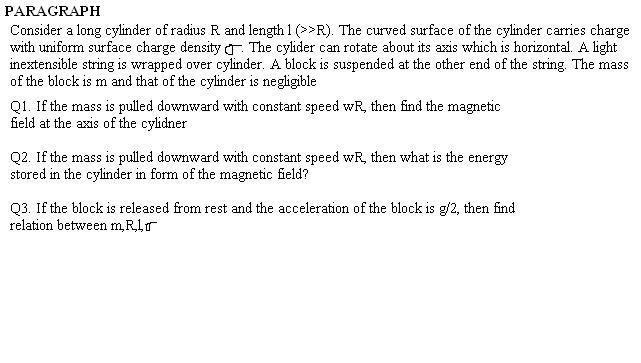din knw whether to put in mechanics or electricity and mag section
-
UP 0 DOWN 0 2 7

7 Answers
I'm getting slightly different results.
i=qf=\frac{q\omega}{2\pi}
M=(\pi r^2)i
B=\frac{\mu_0i}{2\pi r}=\frac{\mu_0 \sigma l\omega}{2\pi}
E=-\vec{M}.\vec{B}=\frac{\mu \sigma^2 r^3 l^2\omega^2}{2}.
Me too getting diff Result....
i=q\omega /2\pi =\sigma \omega rl
The current is being carried by a cylindrical ring of radius r, hence the ring formula will apply B= \mu i/2r=\mu\sigma \omega l/2
The cylinder will act as a solenoid.So energy=B^{2}(\pi r^{2}l)/2\mu...(energy density.volume)
which comes out to be = \mu \sigma ^{2}l^{3}\omega ^{2}\pi r^{2}/8.
The current flows along the curved surface in the tangential direction. If you consider a cross-section through the axis which cuts the lateral surface, then in time Δt, a charge Δq = σ LRω Δt flows across it, hence the surface current I = σ LRω. The current per unit length j = σ Rω.
The situation is very much like a solenoid. The field is uniform and constant along the axis. Applying Ampere's circuital law along a rectangular path whose opposite sides are parallel to the axis, one gets
B = μ0 σ Rω
The energy density could be obtained from the formula
UB = 12 B2μ0
The net force on the block is mg/2. So the tension is T= mg/2. Its torque about the axis of cylinder is TR=mgR/2. Since the cylinder is massless, the net torque must be zero. The torque of the tension is balanced by the torque of the electric force which arises due to the induced electric field.
The flux of the field through the cross section of the cylinder is
φ = B πR2 = μ0 σ Rω πR2
Hence if E be the (tangential) field at a distance R, then
E 2πR = dφ/dt = μ0 σ πR3 dωdt = μ0 σ πR3 g2R
where I used the fact that the angular acceleration of the cylinder is g/2R.
Hence E = 14 μ0 σ gR
The torque of this field force is \int_0^{2\pi}(\sigma R \mathrm d\theta\,L) E R=\int_0^{2\pi}L \sigma R^2 \left(\dfrac{1}{4}\mu_0\sigma gR\right)\mathrm d\theta =\dfrac{\pi}{2}\mu_0 \sigma^2R^3 gL
Equation this to mgR/2, we get
\dfrac{\pi}{2}\mu_0 \sigma^2R^3 gL = \dfrac{1}{2}mgR\quad \Rightarrow \mu_0 \sigma^2(\pi R^2 L)=m
thanks a lot sir.
i have just skimmed thru for now..
as english exams tomorrow...